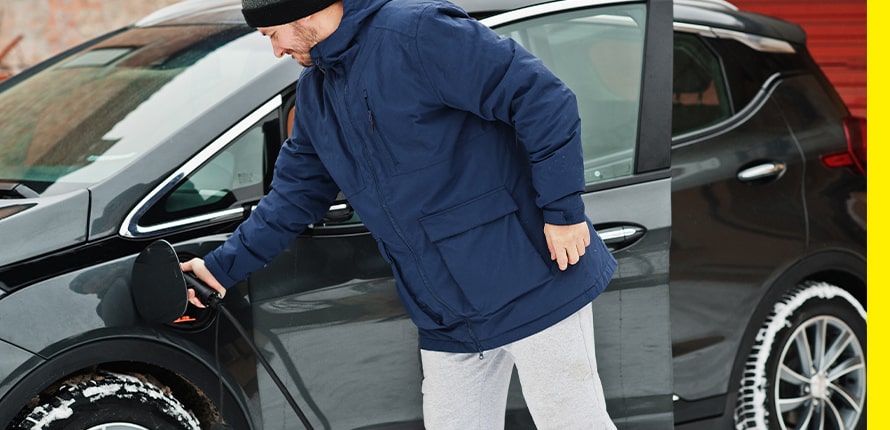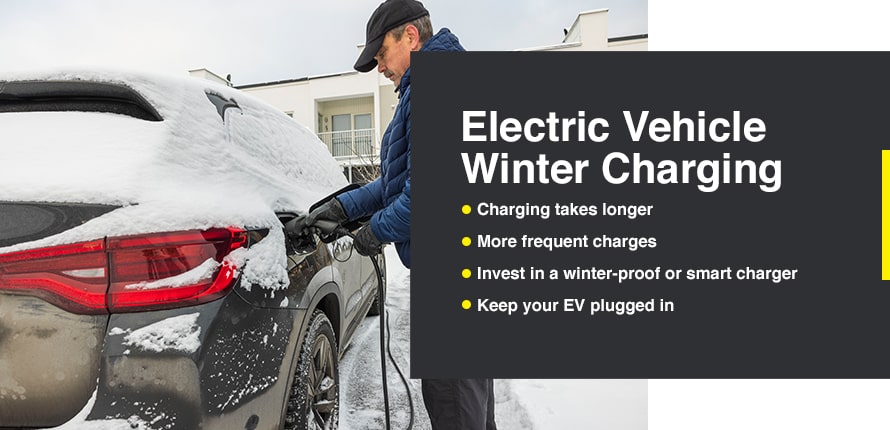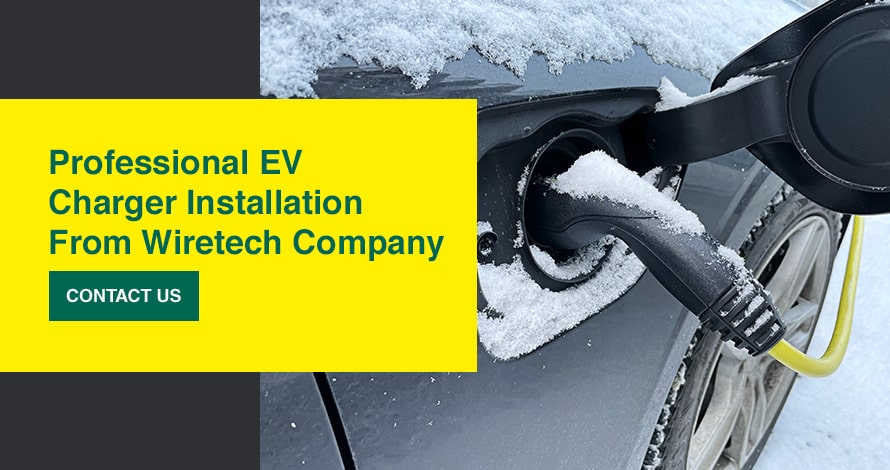
There are numerous advantages to having an electric vehicle (EV), including lower running costs and reduced carbon emissions. It is estimated that less than 1% of the vehicles on the road in the United States currently are electric. However, the EV trend is growing, with experts estimating that electric vehicles will make up nearly 45% of new car sales in 2035.
If you are an EV owner, you need to make sure you know how to care for your EV during the winter. The cold weather affects the battery and can lower its range. You can adjust your driving and charging habits during colder months to ensure your EV maintains its performance level.
How Does Cold Weather Affect an EV?
Similar to how the fuel efficiency of gas-powered vehicles is reduced in winter, the battery efficiency of EVs also decreases. A study by AAA found that EVs have, on average, a 41% decline in long-range mileage in freezing temperatures of 20 degrees Fahrenheit or below when the heater is running. For every 100 miles an EV can travel during the summer, it can only travel 59 miles under the circumstances mentioned above.
There are other elements that can affect the reduction in mileage during winter. Your driving habits, how much charge your battery started with and the temperature of the battery all play a role.
There are a few reasons EVs experience a mileage reduction during the wintertime. One involves the characteristics of lithium-ion batteries. Inside a lithium-ion battery is a liquid electrolyte that acts as a pathway for lithium ions to travel from negative to positive electrodes. The electrolyte can get harder in colder weather, making it more difficult for ions to move between electrodes. Increased internal resistance lowers the efficiency of the battery.
In addition, there is an increase in energy consumption in cold weather. Many EV systems require additional heat to work correctly during the cold winter and pull extra power from the battery to reach adequate operational temperatures. Drivers and passengers also blast heating systems to mitigate the cold. All these factors cause your EV battery to use more power than usual during winter and make it less efficient.

Electric Vehicle Winter Charging
Charging your vehicle correctly and maintaining your battery are the most significant aspects of cold-weather electric vehicle maintenance. Charging your electric car in cold weather is similar to charging it during warm weather, with a couple of differences. Here are a few things to consider when charging electric vehicles at home during winter:
- Charging takes longer: EVs control the charging rate. The EV software reduces charging power in colder temperatures to avoid stressing the battery. Account for the charging period taking a little longer during the wintertime. Rapid charging may also take longer.
- More frequent charges: Charging your vehicle more often ensures you have sufficient battery power. It maximizes the range and performance of the battery. Keeping your battery at 20% and above can help with general battery health.
- Invest in a winter-proof or smart charger: Winter-proof chargers can handle the freezing temperatures of winter and provide efficient charging. Smart chargers allow you to schedule charging for when electricity may be cheaper. There are also smart, winter-proof charger models that offer the best of both chargers.
- Keep your EV plugged in: The EV battery will be warmed up and use less energy when you start it.
EV Cold Weather Driving and Maintenance Tips
Understanding why your EV has lower mileage during the winter can help you combat it. How you approach the colder months with an EV differs from a regular gas-powered vehicle. The main difference is the source of heat. The heat given off by gas engines can help warm the cabin and makes it easier for heating systems to reach the desired temperature. There are no engines in EVs to provide heat. The battery needs to supply heat, which is an energy-intensive process.
Here are some winter tips for electric vehicles:
1. Drive Conservatively
You always need to adjust your driving style according to the weather, regardless of the type of car you drive. For EVs, driving conservatively can help you improve the range of your battery in cold weather. It can also protect you and your passengers on wet, icy winter roads. Here are a few ways you can change your driving habits during winter:
- Maintain a steady speed: Constantly changing your speed and excessive speeding can drain your battery more quickly as it requires more power to keep up with quick changes.
- Brake gently: Sudden braking uses traditional friction brakes instead of the regenerative braking system. The regenerative braking system can help recharge your car when used correctly.
- Accelerate gradually: Sharp acceleration requires significant power. Gentle and gradual acceleration preserves power.
2. Use Eco-Mode
Most electric vehicles have an eco-mode that can extend their battery life span. It makes adjustments to the car’s performance, such as dimming the headlights slightly or reducing the heater’s power to improve the battery range. Using eco-mode during winter can help maintain your battery’s efficiency.
3. Cover Your EV
You can use a tarp or frost cover to protect your EV from cold. A simple cover protects your EV from snow and ice build-up. If you have a garage, ensure you always park your car inside. Being inside can help warm your car and battery, improving its efficiency in winter.
4. Plan Your Route
Planning your route can help you avoid congestion or detours that can quickly use battery power. If you are going somewhere new, take the time to research traffic and potential delays that may affect your travel time. EVs also conserve energy better at speeds under 60mph so try to find routes with a speed limit equal to or below these speeds. You should also plan charging stops along the way if you need to.
5. Preheat the Cabin
Most EVs have a preheat or preconditioning function that allows you to preheat your car while it is still plugged in. The preheat function conserves battery power and makes your vehicle more comfortable to get into. The preheat function also warms the battery to be at its most efficient temperature before you drive.
Also, look for EVs with a heat pump heating system — an energy-efficient heating option that reduces the energy loss that comes with heating your car during winter. A heat pump system can help combat the range loss electric vehicles experience in cold temperatures.
6. Use Regenerative Braking
All EVs on the market in the U.S. have a regenerative braking system. Regenerative braking helps you charge your battery while you are driving. The braking system captures the kinetic energy released when you brake and uses it to recharge your battery. During winter, it can help improve the range of your car. The best way to use the regenerative braking feature is by slowing down gently rather than braking suddenly.
The following EV models use a regenerative braking system:
- Teslas
- Ford Mustang Mach-E
- Chevy Bolt
- Ford Fusion Energi
- Honda Insight
- Nissan Leaf
- Audi E-Tron
- BMW i3
- Kia EV6
Regenerative braking is typically automatic and activates when you lift your foot off the accelerator and apply pressure to the brake. Some models may have specific driving or power modes that need to be activated to use regenerative braking. Consult your owner’s manual or ask your dealer for more information.
7. Get Winter Tires
Winter tires are safer and improve your vehicle’s handling capability regardless of whether electric or gas-powered. You can replace your tires early in winter or fall, especially if your city is known for unexpected snowfall. Ensure you monitor your tire pressure as it can fall with the dropping temperatures. Low tire pressure can increase rolling resistance which may require more power to overcome.
Professional EV Charger Installation From Wiretech Company
The growing popularity of EVs means more homes and businesses need EV chargers installed. At-home chargers require professional electricians for installation. Wiretech Company is an experienced Tesla referred contractor. Our expert technicians can install chargers for other EV car brands, including Chevy, Nissan, BMW and Ford.
Contact us today for professional EV charger installation!

